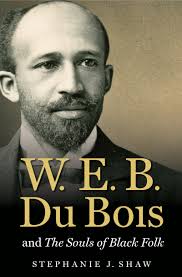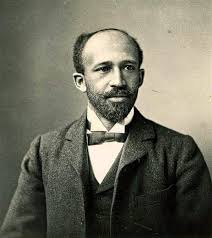The Souls of Black Folk Page #30
The Souls of Black Folk is a 1903 work of American literature by W. E. B. Du Bois. It is a seminal work in the history of sociology and a cornerstone of African-American literature. The book contains several essays on race, some of which the magazine Atlantic Monthly had previously published.
VIII. Of the Quest of the Golden Fleece But the Brute said in his breast, “Till the mills I grind have ceased, The riches shall be dust of dust, dry ashes be the feast! “On the strong and cunning few Cynic favors I will strew; I will stuff their maw with overplus until their spirit dies; From the patient and the low I will take the joys they know; They shall hunger after vanities and still an-hungered go. Madness shall be on the people, ghastly jealousies arise; Brother’s blood shall cry on brother up the dead and empty skies.” WILLIAM VAUGHN MOODY. Have you ever seen a cotton-field white with harvest,—its golden fleece hovering above the black earth like a silvery cloud edged with dark green, its bold white signals waving like the foam of billows from Carolina to Texas across that Black and human Sea? I have sometimes half suspected that here the winged ram Chrysomallus left that Fleece after which Jason and his Argonauts went vaguely wandering into the shadowy East three thousand years ago; and certainly one might frame a pretty and not far-fetched analogy of witchery and dragons’ teeth, and blood and armed men, between the ancient and the modern quest of the Golden Fleece in the Black Sea. And now the golden fleece is found; not only found, but, in its birthplace, woven. For the hum of the cotton-mills is the newest and most significant thing in the New South to-day. All through the Carolinas and Georgia, away down to Mexico, rise these gaunt red buildings, bare and homely, and yet so busy and noisy withal that they scarce seem to belong to the slow and sleepy land. Perhaps they sprang from dragons’ teeth. So the Cotton Kingdom still lives; the world still bows beneath her sceptre. Even the markets that once defied the parvenu have crept one by one across the seas, and then slowly and reluctantly, but surely, have started toward the Black Belt. To be sure, there are those who wag their heads knowingly and tell us that the capital of the Cotton Kingdom has moved from the Black to the White Belt,—that the Negro of to-day raises not more than half of the cotton crop. Such men forget that the cotton crop has doubled, and more than doubled, since the era of slavery, and that, even granting their contention, the Negro is still supreme in a Cotton Kingdom larger than that on which the Confederacy builded its hopes. So the Negro forms to-day one of the chief figures in a great world-industry; and this, for its own sake, and in the light of historic interest, makes the field-hands of the cotton country worth studying. We seldom study the condition of the Negro to-day honestly and carefully. It is so much easier to assume that we know it all. Or perhaps, having already reached conclusions in our own minds, we are loth to have them disturbed by facts. And yet how little we really know of these millions,—of their daily lives and longings, of their homely joys and sorrows, of their real shortcomings and the meaning of their crimes! All this we can only learn by intimate contact with the masses, and not by wholesale arguments covering millions separate in time and space, and differing widely in training and culture. To-day, then, my reader, let us turn our faces to the Black Belt of Georgia and seek simply to know the condition of the black farm-laborers of one county there. Here in 1890 lived ten thousand Negroes and two thousand whites. The country is rich, yet the people are poor. The keynote of the Black Belt is debt; not commercial credit, but debt in the sense of continued inability on the part of the mass of the population to make income cover expense. This is the direct heritage of the South from the wasteful economies of the slave régime; but it was emphasized and brought to a crisis by the Emancipation of the slaves. In 1860, Dougherty County had six thousand slaves, worth at least two and a half millions of dollars; its farms were estimated at three millions,—making five and a half millions of property, the value of which depended largely on the slave system, and on the speculative demand for land once marvellously rich but already partially devitalized by careless and exhaustive culture. The war then meant a financial crash; in place of the five and a half millions of 1860, there remained in 1870 only farms valued at less than two millions. With this came increased competition in cotton culture from the rich lands of Texas; a steady fall in the normal price of cotton followed, from about fourteen cents a pound in 1860 until it reached four cents in 1898. Such a financial revolution was it that involved the owners of the cotton-belt in debt. And if things went ill with the master, how fared it with the man? The plantations of Dougherty County in slavery days were not as imposing and aristocratic as those of Virginia. The Big House was smaller and usually one-storied, and sat very near the slave cabins. Sometimes these cabins stretched off on either side like wings; sometimes only on one side, forming a double row, or edging the road that turned into the plantation from the main thoroughfare. The form and disposition of the laborers’ cabins throughout the Black Belt is to-day the same as in slavery days. Some live in the self-same cabins, others in cabins rebuilt on the sites of the old. All are sprinkled in little groups over the face of the land, centering about some dilapidated Big House where the head-tenant or agent lives. The general character and arrangement of these dwellings remains on the whole unaltered. There were in the county, outside the corporate town of Albany, about fifteen hundred Negro families in 1898. Out of all these, only a single family occupied a house with seven rooms; only fourteen have five rooms or more. The mass live in one- and two-room homes. The size and arrangements of a people’s homes are no unfair index of their condition. If, then, we inquire more carefully into these Negro homes, we find much that is unsatisfactory. All over the face of the land is the one-room cabin,—now standing in the shadow of the Big House, now staring at the dusty road, now rising dark and sombre amid the green of the cotton-fields. It is nearly always old and bare, built of rough boards, and neither plastered nor ceiled. Light and ventilation are supplied by the single door and by the square hole in the wall with its wooden shutter. There is no glass, porch, or ornamentation without. Within is a fireplace, black and smoky, and usually unsteady with age. A bed or two, a table, a wooden chest, and a few chairs compose the furniture; while a stray show-bill or a newspaper makes up the decorations for the walls. Now and then one may find such a cabin kept scrupulously neat, with merry steaming fireplaces and hospitable door; but the majority are dirty and dilapidated, smelling of eating and sleeping, poorly ventilated, and anything but homes.
Translation
Translate and read this book in other languages:
Select another language:
- - Select -
- 简体中文 (Chinese - Simplified)
- 繁體中文 (Chinese - Traditional)
- Español (Spanish)
- Esperanto (Esperanto)
- 日本語 (Japanese)
- Português (Portuguese)
- Deutsch (German)
- العربية (Arabic)
- Français (French)
- Русский (Russian)
- ಕನ್ನಡ (Kannada)
- 한국어 (Korean)
- עברית (Hebrew)
- Gaeilge (Irish)
- Українська (Ukrainian)
- اردو (Urdu)
- Magyar (Hungarian)
- मानक हिन्दी (Hindi)
- Indonesia (Indonesian)
- Italiano (Italian)
- தமிழ் (Tamil)
- Türkçe (Turkish)
- తెలుగు (Telugu)
- ภาษาไทย (Thai)
- Tiếng Việt (Vietnamese)
- Čeština (Czech)
- Polski (Polish)
- Bahasa Indonesia (Indonesian)
- Românește (Romanian)
- Nederlands (Dutch)
- Ελληνικά (Greek)
- Latinum (Latin)
- Svenska (Swedish)
- Dansk (Danish)
- Suomi (Finnish)
- فارسی (Persian)
- ייִדיש (Yiddish)
- հայերեն (Armenian)
- Norsk (Norwegian)
- English (English)
Citation
Use the citation below to add this book to your bibliography:
Style:MLAChicagoAPA
"The Souls of Black Folk Books." Literature.com. STANDS4 LLC, 2025. Web. 10 Jan. 2025. <https://www.literature.com/book/the_souls_of_black_folk_310>.




Discuss this The Souls of Black Folk book with the community:
Report Comment
We're doing our best to make sure our content is useful, accurate and safe.
If by any chance you spot an inappropriate comment while navigating through our website please use this form to let us know, and we'll take care of it shortly.
Attachment
You need to be logged in to favorite.
Log In